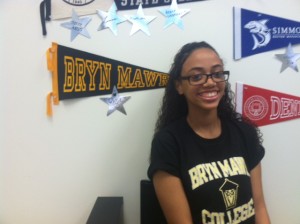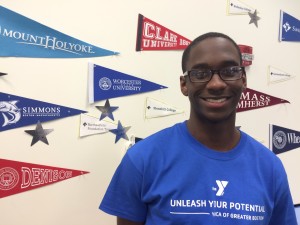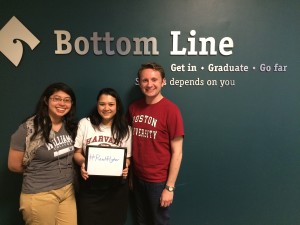
Access Counselor, Evan Soken preps his student for the big May 1st deadline
My student lifted their eyes to the wall thick with college pennants, searching for their future school. Each flag was surrounded by a cluster of colorful stars, each star bearing the name of a student who had committed to that college from the Class of 2016. A smile of recognition flickered across their face as Northeastern caught their eye. “It’s so high! How am I supposed to get up there?” they exclaimed. “You think you can jump that high?” I laughed. After taking a beat, they took a running jump and slapped their star directly below the Northeastern pennant as applause rippled through the room.
Spring is one of my favorite seasons in the college access world. Every piece of the process comes with unique challenges and rewards, but especially as a second-year counselor at Bottom Line, the weeks leading up to May 1 are the culmination of months of student work. May 1 is National College Decision Day in the United States — the day when nearly every college in the country requires that students commit to a college by sending a deposit to secure their place in the class. At Bottom Line, we plan for this day all year. From the first time we meet with a student during the summer before their senior year, we are thinking about how to troubleshoot all the obstacles that might stand between them and a good-fit, affordable, post-secondary option on May 1. As we partner with students to build a diverse college list, edit countless essays, complete the FAFSA, and troubleshoot financial and citizenship issues we are always thinking about giving the student as many options as possible. By the time April rolls around, students prepare to have one of their final meetings in our Access Program: the Award Analysis Meeting.
While there are many valuable meetings and services that students participate in during their senior year, the Award Analysis Meeting is a game-changer. Using an Excel tool that helps breakdown financial aid letters into government/institutional money and federal loans, we estimate the cost of their different colleges for freshman year. Then we take it one step further and estimate the four-year cumulative cost and monthly loan repayment for each college as well. Financing college is one of the most significant barriers low-income, first-generation college students face. Fluctuating financial aid and lack of clear information about paying for college often result in student dropout. This meeting with students is meant to empower them to think about the long-term consequences of their different college choices. It pushes the counselor, the student, and their family to think in concrete, specific terms: What is your plan to pay your first bill in August? Where is that money coming from? Will you have access to that money over four years? While these conversations are almost never easy or simple, walking through these tough questions with all parties involved dramatically increases a student’s ability to confidently make a choice that will move them towards their college degree.
At the end of the day all the services we provide are about giving students the tools to make a college choice that will set them up for success — not just for next year — but for the next four years, as they earn their degree, and the next ten years as they start their post-college lives. People often say to me, “This must be such a rewarding time of year for you!” It is rewarding, but the reward doesn’t belong to me—it belongs to my students who have used the resources available to them to advocate for themselves, to grow, and to learn. This is their moment and I am privileged to have been a part of it.
-Written by Bottom Line Access Counselor, Evan Soken

Rosellen is off to Bryn Mawr!

Jean will attend Northeastern Foundation Year in the fall!

Our Dorchester Access Counselors rep their alma maters!

Brandon commits to Swathmore!













